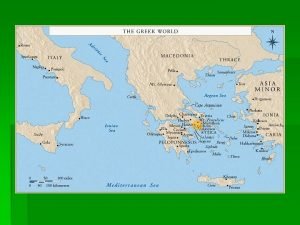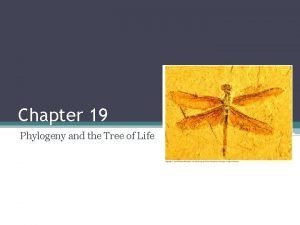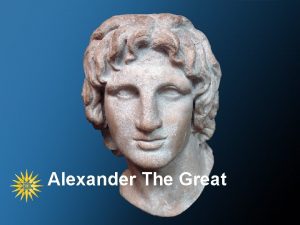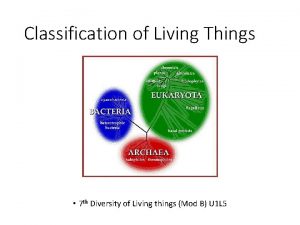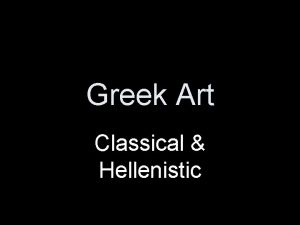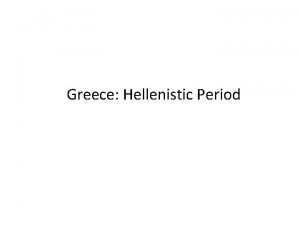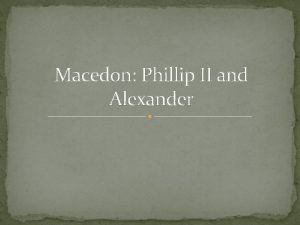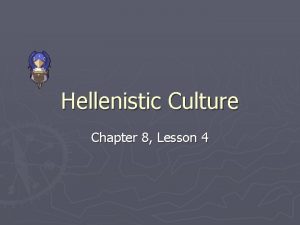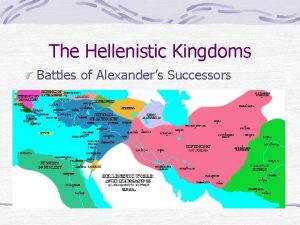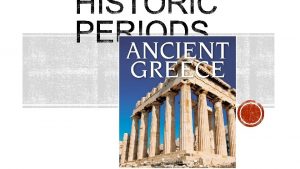HELLENISTIC ART The Hellenistic Period Phillip II Alexander










































- Slides: 42


HELLENISTIC ART

The Hellenistic Period Phillip II Alexander

The Hellenistic Period This map shows how Alexander the Great’s kingdom was broken down after his death. His death marked the beginning of the Hellenistic (or “Greek-like”) period.

Hellenistic Period Architecture & Architecture Sculpture

THE HELLENISTIC PERIOD (323 -31 B. C. ) » The Hellenistic period spans the three centuries from the death of Alexander the Great in 323 BCE to the beginning of the Roman imperial period under Augustus. » Alexander's far-flung empire was divided up after his death among his Greek generals who cultivated a new, cosmopolitan, Greek-based culture, called Hellenistic. » Sculpture: • Hellenistic sculpture exhibits a "baroque" exaggeration of form and expressive emotional intensity. • Physical movement and gesture are given theatrical pathos and drama. • Moreover, statues are made to interact with their environment, sometimes as part of a tableau, which heightens the illusion of their presence and actions. • Both female and male figures display heightened erotic sensuality as the body is explored both in action and repose. • Hellenistic sculptors also expanded the range of subject types by drawing from the lower social classes and including more realistic portraits and images of children and old people

POLYKLEITOS THE YOUNGER, Corinthian capital, from the Tholos, Epidauros, Greece, ca. 350 BCE. Archaeological Museum, Epidauros.

Corinthian capitals • Polykleitos the Younger • Capitals from the Tholos at Epidauros, Greece, ca. 350 B. C. • More ornate than the earlier capitals • A double row of acanthus leaves with flowers & tendrils • Invented by the sculptor Kallimachos • Corinthian became the most popular of all capital designs.

Temple Of Olympian Zeus 175 -132 BCE, Athens. Corinthian Style Greek Order – not just for interiors anymore


Choragic Monument of Lysikrates, Athens, Greece, 334 BCE. This is the first example of Corinthian capitals on a Greek building – topping the engaged columns and one is also sitting atop the roof.

Stoa of Attalos II, Agora, Athens, Greece, ca. 150 BCE (Acropolis in the background). A “Stoa” is a covered colonnade or portico housing shops or offices.

Hellenistic Period Sculpture

THE HELLENISTIC PERIOD (323 -31 B. C. ) • The Hellenistic period spans the three centuries from the death of Alexander the Great in 323 BCE to the beginning of the Roman imperial period under Augustus. • Alexander's far-flung empire was divided up after his death among his Greek generals who cultivated a new, cosmopolitan, Greek-based culture, called Hellenistic. • Sculpture: • Hellenistic sculpture exhibits a "baroque" exaggeration of form and expressive emotional intensity. • Physical movement and gesture are given theatrical pathos and drama. • Moreover, statues are made to interact with their environment, sometimes as part of a tableau, which heightens the illusion of their presence and actions. • Both female and male figures display heightened erotic sensuality as the body is explored both in action and repose. • Hellenistic sculptors also expanded the range of subject types by drawing from the lower social classes and including more realistic portraits and images of children and old people

Figure 5 -78 Reconstructed west front of the Altar of Zeus, from Pergamon, Turkey, ca. 175 BCE. Staatliche Museen, Berlin.

Altar of Zeus, Pergamon, ca. 175 B. C • This is the most famous of all Hellenistic Sculptural ensembles. • Sculpted frieze is 400 feet, with 100 larger than life size figures. • The subject is the battle of the Gods & giants.

Pergamon • The kingdom of Pergamon enjoyed great wealth and power for 100 years or more before it was absorbed into the Roman Empire in 133 BCE. • During this time, the city of Pergamon was embellished with two important monuments commemorating the defeat of invading Gauls: • a statuary group set up on the city's acropolis • and a massive Ionic altar with a frieze showing the battle of the gods and giants

Athena Battling Alkyoneos Pergamon, Turkey, ca 175 BCE. HELLENISTIC Describes the battle between gods and the giants. The giants, as helpless tools, were dragged up the stairs to worship the gods The gods’ victory over the giants offers a parallel to Alexander the Great’s defeat of the Persians Deeply carved figures overlap and show mastery of depth, space, drama and musculature

• Detail of the gigantomachy frieze of the Altar of Zeus, • Marble, approx. 7' 6" high High relief • The Pergamene Baroque style high relief sculpture portrays a tumultuous narrative with emotional intensity, violent movement and vivid depictions of death and suffering. Athena battling Alkyoneos

Figure 5 -79 Athena battling Alkyoneos, detail of the gigantomachy frieze, from the Altar of Zeus, Pergamon, Turkey. Marble, approx. 7’ 6” high. Staatliche Museen, Berlin. The Pergamon Altar – Sm. ART History video

The sculptor carefully studied and reproduced the distinctive features of the foreign Gauls, most notably their long, bushy hair and mustaches and torques (neck bands) they frequently wore. Here, the chieftain drives a sword into his own chest after having already killed his own wife, as it is evident that he prefers suicide to surrender and an indefinite life of slavery. In the best Lysippan tradition, the group only can be fully appreciated by walking around it. From one side the observer sees the Gaul’s intensely expressive face, from another his powerful body, and from a third the woman’s limp and almost lifeless body. Figure 5 -80 EPIGONOS(? ), Gallic chieftain killing himself and his wife. Roman marble copy after a bronze original from Pergamon, Turkey, ca. 230– 220 BCE, approx. 6’ 11” high. Museo Nazionale Romano-Palazzo Altemps, Rome.

Figure 5 -80 Detail Upper two thirds of the Gaul and his dead wife from front right © 2005 Saskia Cultural Documentation, Ltd.

Dying Gaul, Pergamon, Turkey ca. 230 -220 BCE The depiction of a variety of ethnic groups was a new concept in Greek art and one that would be pushed much further throughout the Hellenistic age. Again, this depiction is reflective of the drama seen on the stages of the Greek amphitheaters at this time. The dying Gaul winces in pain as blood pours from the large gash in his chest. The concept of pathos became increasingly popular toward the end of the history of Greek sculpture. The musculature was rendered in an exaggerated manner. Note the chest’s tautness and the left leg’s bulging veins ---- implying that the unseen hero who has struck down this noble and savage foe must have been an extraordinary man.

Figure 5 -81 EPIGONOS(? ), Dying Gaul. Roman marble copy after a bronze original from Pergamon, Turkey, ca. 230– 220 BCE, approx. 3’ 1/2” high. Museo Capitolino, Rome. Dying Gaul – Sm. ART History video

Dying Warrior C 500 -490 BCE ARCHAIC GREEK Dying Gaul ca. 230 -220 BC HELLENISTIC

• One of the masterpieces of the Hellenistic baroque style was set up in the sanctuary of the Great Gods on Samothrace. • Nike was originally in the top tier of a 2 tiered fountain with the water mimicking “waves” crashing against the bow of the ship • Notice the captured action, the wings still beating, her dress blown tightly across the body, very theatrical. • Hellenistic statues were not created to be placed on pedestals, rather they interact with the environment Nike alighting on a warship (Nike of Samothrace), from Samothrace, Greece, ca. 190 BCE. Marble, figure approx. 8’ 1” high. Louvre, Paris.

Nike of Samothrace, Greece ca. 190 BCE The wind sweeps her drapery. Her himation bunches in thick folds around her right leg, and her chiton is pulled tightly across her abdomen and left leg. The statues theatrical effect was amplified by its setting. This sculpture was part of a two-tiered fountain. In the lower basin were large boulders. The fountain’s flowing water created the illusion of rushing waves dashing up against the ship. The sound of splashing water added an to the sense of drama. Art and nature were combined.

Aphrodite (of Melos) Melos, Greece ca. 150 -125 BC HELLENISTIC GREEK This demonstrates that the “undressing” of Aphrodite by Praxiteles had become the norm by this point in Greek art, but Hellenistic sculptors went beyond the Late Classical master an openly explored the female form’s eroticism. Her left hand (separately preserved) holds the apple Paris awarded her when he judged her as the most beautiful goddess of all. Her right hand may have lightly grasped the edge of her drapery near the left hip in a halfhearted attempt to keep it from slipping farther down her body. Much more sensual than the nude Venus by Praxiteles even though she is more modestly covered. One of her hands held the drapery to keep it from “falling”, designed to “tease” the spectator

Aphrodite, Eros, and Pan, from Delos, Greece, ca. 100 BCE. Marble, 4’ 4” high. National Archaeological Museum, Athens. This is an even more irreverent portrayal of Aphrodite as she “resists” the lecherous advances of Pan with the aid of Eros. The statue was erected in a businessmen’s clubhouse. Notice the realistic portrayal of the infant – he is not a miniature adult.

Hellenistic sculptors often portrayed sleep. This concept is the antithesis of the Classical ideals of rationality and discipline. The saytr, a follower of Dionysos, has had too much wine and has fallen into an intoxicated sleep. It is not surprising that when Hellenistic sculptors began to explore the human body’s sexuality, they turned their attention to both men and women. Compare the sexuality of this sculpture with that of the early Archaic kouros figures. Archaic statues smile at their viewers. Classical statues always look awake & alert. This work is blatantly sensual. Notice the wantonly spread legs bringing the focus to the groin. Sleeping Saytr (Barberini Faun) Rome, Italy ca. 230 -220 BCE

Figure 5 -85 Alternate View Full length front center © 2005 Saskia Cultural Documentation, Ltd.

Seated boxer, from Rome, Italy, ca. 100– 50 BCE. Bronze, approx. 4’ 2 1/2” high. Museo Nazionale Romano, Rome.

Hellenistic sculptors often rendered the common theme of the male athlete in a new way. This boxer is not a victorious young athlete with a perfect face and body, but rather a heavily battered, defeated veteran whose upward gaze may have been directed at the man who had just beaten him. This boxer’s broken nose, distorted face, bleeding wounds and “cauliflower ears” add the sense of realism that the Hellenistic artists sought. Although Hellenistic sculptors tackled an expanded range of subjects, they did not abandon such traditional themes as the Greek athlete The appeal is to the viewers’ emotions rather than intellect. Seated Boxer Bronze, c 100 BCE. HELLENISTIC GREEK

Riace Warrior Early Classical Greek Seated Boxer Hellenistic Greek

This is one of a series of statues of old men and women from the lowest rungs of the social order. Shepherds, fishermen, and drunken beggars are common- the kind of people who were pictured earlier on redfigure vases but never before were thought worthy of monumental statuary. Hellenistic art reflects a new and unstable social climate in Greece. Social instability gave way to the depiction of a much wider variety of physical types, including different ethnic types. The trend toward realism in Hellenistic sculpture – the very opposite of the Classical period's idealism The purpose of these statues is unknown. The sculptures attest to the social realism of the Hellenistic Age, but they also contrast with more typical renderings of young & beautiful figures. Old Market Woman ca. 150 -100 BC HELLENISTIC GREEK

Lysippos, Apoxyomenos (The Scraper) ca. 325 BC (Roman copy) HELLENISTIC GREEK Apoxyomenos (the "Scraper") is one of the conventional subjects of ancient Greek sculpture; it represents an athlete, caught in the familiar act of scraping sweat and dust from his body with the small curved instrument. The most renowned Apoxyomenos in Classical Antiquity was that of Lysippos of Sikyon, the court sculptor of Alexander the Great, made ca 330 BCE. The bronze original is lost, but it has been copied numerous times by the Romans.

A Roman poet vividly described the strangling of Laocoön and his two sons by sea serpents while sacrificing at an altar. The gods who favored the Greeks in the war against Troy had sent the serpents to punish Laocoön, who had tried to warn his compatriots about the danger of bringing the Greeks’ wooden horse within the walls of their city. Everything about this piece speaks to the Hellenistic ideal. The facial expressions are exaggerated, the muscles fully flexed, dramatic movement is indicated, and strong diagonals dominate the composition. Laocoön and his sons Early 1 st century CE HELLENISTIC GREEK

Athena battling Alkyoneos detail of the gigantomachy frieze, from the Altar of Zeus, Pergamon, Turkey. Marble, approx. 7’ 6” high. Staatliche Museen, Berlin. ATHANADOROS, HAGESANDROS, and POLYDOROS OF RHODES, Laocoön and his sons, from Rome, Italy, early first century CE Marble, approx. 7’ 10 1/2” high. Vatican Museums, Rome.

Petra (UNESCO/NHK) 2: 39 Petra: Ancient. City 2: 28



 Corinthian capital
Corinthian capital Lesson 5 alexander and the hellenistic era
Lesson 5 alexander and the hellenistic era What are the characteristics of a greek sculpture
What are the characteristics of a greek sculpture King phillip came over for good soup
King phillip came over for good soup King phillip came over from great spain
King phillip came over from great spain Dear king phillip came over
Dear king phillip came over Kingdom chart
Kingdom chart Dear king phillip came over
Dear king phillip came over King philip kingdom phylum
King philip kingdom phylum Philip bayard
Philip bayard Phillip gilley
Phillip gilley Domains and kingdoms
Domains and kingdoms Deacon phillip
Deacon phillip King phillip acronym
King phillip acronym Dear king phillip came over
Dear king phillip came over Dear king phillip came over for good spaghetti
Dear king phillip came over for good spaghetti Benefits of prokaryotes
Benefits of prokaryotes Linnaean classification
Linnaean classification Bufonaria borisbeckeri
Bufonaria borisbeckeri Phillip of macedon
Phillip of macedon Dr phillip williams
Dr phillip williams Fuck you and your mum
Fuck you and your mum Tecnica phillips 6/6
Tecnica phillips 6/6 Philip scherrer
Philip scherrer Gunho sohn
Gunho sohn What conflict is introduced in this excerpt? justin lebo
What conflict is introduced in this excerpt? justin lebo Phillip lah
Phillip lah The cay phillip character traits
The cay phillip character traits Stayz busselton
Stayz busselton Phillip crisp
Phillip crisp Legend of zelda game java
Legend of zelda game java Phillip crisp
Phillip crisp Phillip juengst
Phillip juengst King phillip came over for good spaghetti
King phillip came over for good spaghetti Phillip crisp
Phillip crisp Phillip crisp
Phillip crisp Phillip leung
Phillip leung Phillip gardiner tobacco
Phillip gardiner tobacco Phillip burns
Phillip burns Cartas de smith
Cartas de smith Phillip de vos
Phillip de vos Dichotomous key is used to
Dichotomous key is used to Cynthia lightfoot
Cynthia lightfoot


